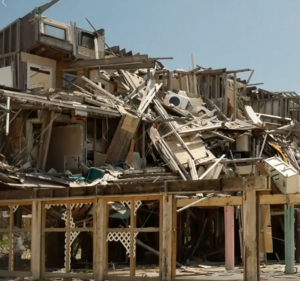Greater federal cost-sharing credited

President Trump in Panama City Beach, Florida, May 8, 2019
Florida scored a big win with the President’s recent visit to the Panhandle, with his announcement that the federal government’s cost sharing of Hurricane Michael recovery will increase from 75% to 90%. The Governor in the meantime has provided a new loan program for hard-hit farmers and cash advances for rebuilding. While Congress continues to stall on a multi-billion federal disaster aid package, the FCC is out with a report on why cellphone service took such a big hit during the Category 5 storm.
President Trump visited Panama City Beach on May 8 and brought with him the good news that he’d said yes to the Governor’s request to increase federal cost sharing, given the enormity of the storm. The federal reimbursement will be increased to 90% for hurricane recovery “in many circumstances,” said the President, with state and local municipalities responsible for the remaining 5% each. The FEMA money will reimburse for cleanup of the estimated 20 million cubic tons of debris, building repair, mitigation projects, and extra security measures. The increased cost sharing will save Florida more than $500 million in storm recovery costs over the next two years, according to state Emergency Management Director Jared Moskowitz.

Oceanfront Damage in Mexico Beach, Florida
The President also said $448 million in U.S. Housing and Urban Development (HUD) disaster recovery funds were being designated to the state to help rebuild housing lost during Michael. Three in every four buildings in Bay County – ground zero for the storm – are estimated to be damaged, with thousands of residents displaced since its October 10 landfall.
Larger federal relief, in the form of a now $19.1 billion disaster relief bill for Florida and other disaster-ravaged states, was approved by the U.S. House of Representatives last week. (It includes another short-term reauthorization of the National Flood Insurance Program, which expires May 31.) But the U.S. Senate has failed to act over ongoing squabbling about extra money for Puerto Rico. Part of the money is needed to rebuild Tyndall Air Force Base just east of Panama City. So seven months post-storm, we continue to wait.
FEMA continues its standard reimbursements for costs of debris removal, with a recent $2 million check to the state and $1.3 million to the town of Parker. Panama City was just awarded $2.4 million – the second half of expedited funding for emergency protective measures taken during and right after the storm.
Meanwhile, just in time for the start of growing season, the Governor last week announced he’s making available about $25 million to Panhandle farmers through the state’s Small Business Emergency Loan Program. He’s also directed that special federal cash advances available to Florida be used to help local municipalities rebuild government facilities, including schools, damaged in the storm. The Governor also approved a back-to-school sales tax holiday and one for disaster preparedness supplies, the latter running May 31-June 6, coinciding with the start of the Atlantic hurricane season. There’s also a rebate on taxes paid on fuels used to truck hurricane debris and agricultural shipments, and another on taxes for repairs to farm buildings and fences.

A cell phone tower in Panama City, Florida damaged from Hurricane Michael
The Federal Communications Commission last week released a report on the big hit the Panhandle’s cellular phone network took from Michael’s 160 mph winds. Almost half the cell sites in Bay County were still down a week after landfall. The report noted “Hurricane Michael demonstrated starkly how some wireless providers were able to rebound from this devastating storm through foresight and appropriate planning, while others stalled in their efforts to restore service.” The delay was due essentially to three factors: insufficiently resilient connectivity, inadequate reciprocal roaming agreements, and a lack of coordination among wireless providers, power crews, and municipalities.
LMA Newsletter of 5-20-19

